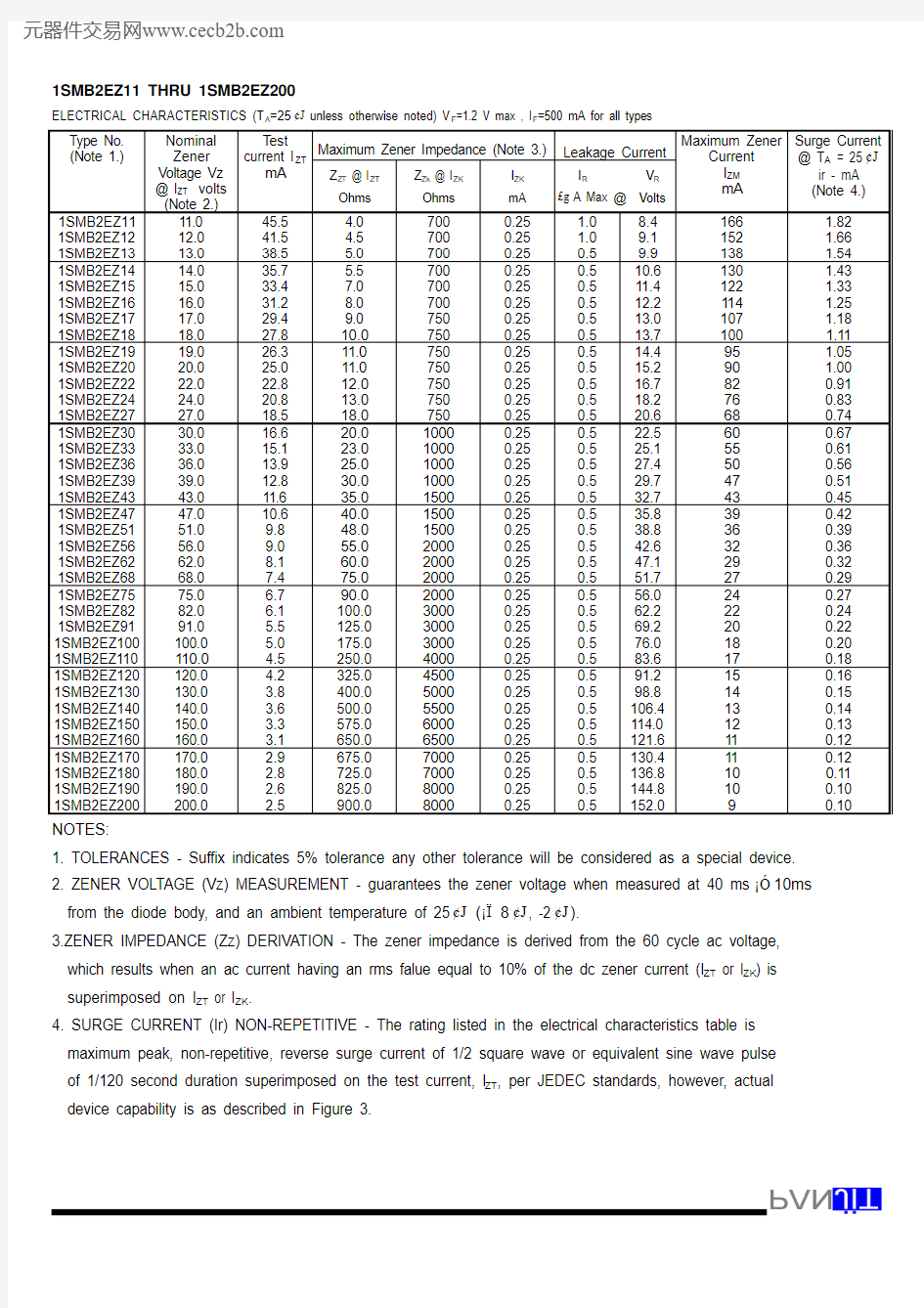1SMB2EZ20中文资料


1SMB2EZ11 THRU 1SMB2EZ200
SURFACE MOUNT SILICON ZENER DIODE VOLTAGE - 11 TO 200 Volts Power - 2.0 Watts
FEA TURES
l Low profile package l Built-in strain relief
l Glass passivated junction l Low inductance
l Excellent clamping capability
l Typical I D less than 1£g A above 11V l High temperature soldering : 260¢J /10 seconds at terminals
l Plastic package has Underwriters Laboratory Flammability Classification 94V-O MECHANICAL DATA
Case: JEDEC DO-214AA, Molded plastic over passivated junction
Terminals: Solder plated, solderable per MIL-STD-750, method 2026
Polarity: Color band denotes positive end (cathode) except Brdirectional
Standard Packaging: 12mm tape (EIA-481)Weight: 0.003 ounce, 0.093 gram
MAXIMUM RA TINGS AND ELECTRICAL CHARACTERISTICS
Ratings at 25¢J ambient temperature unless otherwise specified.
SYMBOL
VALUE
UNITS Peak Pulse Power Dissipation (Note A)Derate above 75¢J
P D 224Watts mW/¢J Peak forward Surge Current 8.3ms single half sine-wave superimposed on rated load(JEDEC Method) (Note B)
I FSM 15Amps Operating Junction and Storage Temperature Range T J ,T STG -55 to +150
¢J
NOTES:
A. Mounted on 5.0mm 2
(.013mm thick) land areas.
B. Measured on 8.3ms, single half sine-wave or equivalent square wave, duty cycle = 4 pulses per minute maximum.
DO-214AA
1SMB2EZ11 THRU 1SMB2EZ200
ELECTRICAL CHARACTERISTICS (T A =25¢J unless otherwise noted) V F =1.2 V max , I F =500 mA for all types
Maximum Zener Impedance (Note 3.)Leakage Current Type No.(Note 1.)
Nominal Zener Voltage Vz @ I ZT volts (Note 2.)T est current I ZT mA Z ZT @ I ZT Ohms Z Zk @ I ZK Ohms I ZK mA I R £g A Max @V R
Volts Maximum Zener Current I ZM mA Surge Current
@ T A = 25¢J
ir - mA (Note 4.)1SMB2EZ111SMB2EZ121SMB2EZ1311.012.013.045.5
41.538.5 4.04.55.07007007000.250.250.25 1.01.00.58.49.19.9166152138 1.821.661.541SMB2EZ141SMB2EZ151SMB2EZ161SMB2EZ171SMB2EZ1814.015.016.017.018.035.733.431.229.427.8 5.57.08.09.010.07007007007507500.250.250.250.250.250.50.50.50.50.510.611.412.213.013.7130122114107100 1.431.331.251.181.111SMB2EZ191SMB2EZ201SMB2EZ221SMB2EZ241SMB2EZ2719.020.022.024.027.026.325.022.820.818.511.011.012.013.018.07507507507507500.250.250.250.250.250.50.50.50.50.514.415.216.718.220.69590827668 1.051.000.910.830.741SMB2EZ301SMB2EZ331SMB2EZ361SMB2EZ391SMB2EZ4330.033.036.039.043.016.615.113.912.811.620.023.025.030.035.0100010001000100015000.250.250.250.250.250.50.50.50.50.522.525.127.429.732.760555047430.670.610.560.510.451SMB2EZ471SMB2EZ511SMB2EZ561SMB2EZ621SMB2EZ6847.051.056.062.068.010.69.89.08.17.440.048.055.060.075.0150015002000200020000.250.250.250.250.250.50.50.50.50.535.838.842.647.151.739363229270.420.390.360.320.291SMB2EZ751SMB2EZ821SMB2EZ911SMB2EZ1001SMB2EZ11075.082.091.0100.0110.0 6.76.15.55.04.590.0100.0125.0175.0250.0200030003000300040000.250.250.250.250.250.50.50.50.50.556.062.269.276.083.624222018170.270.240.220.200.181SMB2EZ1201SMB2EZ1301SMB2EZ1401SMB2EZ1501SMB2EZ160120.0130.0140.0150.0160.0 4.23.83.63.33.1325.0400.0500.0575.0650.0450050005500600065000.250.250.250.250.250.50.50.50.50.591.298.8106.4114.0121.615141312110.160.150.140.130.121SMB2EZ1701SMB2EZ1801SMB2EZ1901SMB2EZ200
170.0180.0190.0200.0
2.92.82.62.5
675.0725.0825.0900.0
7000700080008000
0.250.250.250.25
0.50.50.50.5
130.4136.8144.8152.0
1110109
0.120.110.100.10
NOTES:
1. TOLERANCES - Suffix indicates 5% tolerance any other tolerance will be considered as a special device.
2. ZENER VOLTAGE (Vz) MEASUREMENT - guarantees the zener voltage when measured at 40 ms ?ó10ms from the diode body, and an ambient temperature of 25¢J (??8¢J , -2¢J ).
3.ZENER IMPEDANCE (Zz) DERIVATION - The zener impedance is derived from the 60 cycle ac voltage, which results when an ac current having an rms falue equal to 10% of the dc zener current (I ZT or I ZK ) is superimposed on I ZT or I ZK .
4. SURGE CURRENT (Ir) NON-REPETITIVE - The rating listed in the electrical characteristics table is maximum peak, non-repetitive, reverse surge current of 1/2 square wave or equivalent sine wave pulse of 1/120 second duration superimposed on the test current, I ZT , per JEDEC standards, however, actual device capability is as described in Figure 3.
0.00010.0002
0.0005
0.001
0.002
0.005
0.01
0.02
0.05
0.1
0.2
0.5
1
2
5
10
Fig. 2-TYPICAL THERMAL RESPONSE L,
P.W. PULSE WIDTH (ms)
0.10.050.030.020.010.0050.0030.0020.0010.00050.00030.00020.0001 1
25102050100200500
1K
NOMINAL VZ (VOLTS)
Fig. 3-MAXIMUM SURGE POWER
Fig. 4-TYPICAL REVERSE LEAKAGE
VZ, ZENER VOLTAGE @IZT (VOLTS)
VZ, ZENER VOLTAGE @IZT (VOLTS)
Fig. 5-UNITS TO 12 VOLTS Fig. 6-UNITS 10 TO 200 VOLTS
VZ, ZENER VOLTAGE (VOLTS)
VZ, ZENER VOLTAGE (VOLTS)
Fig. 7-VZ = 3.9 THRU 10 VOLTS Fig. 8-VZ = 12 THRU 82 VOLTS
VZ, ZENER VOLTAGE (VOLTS)
L, LEAD LENGTH TO HEAT SINK (INCH)
Fig. 9-VZ = 100 THRU 200 VOLTS Fig. 10-TYPICAL THERMAL RESISTANCE
APPLICATION NOTE:
Since the actual voltage available from a given zener diode is temperature dependent, it is necessary to determine junction temperature under any set of operating conditions in order to calculate its value. The following procedure is recommended:
Lead Temperature, T L, should be determined from:
TL = £c LA P D + T A
£c LA is the lead-to-ambient thermal resistance (¢J/W) and P D is the power dissipation. The value for £c LA will vary and depends on the device mounting method.
£c LA is generally 30-40¢J/W for the various chips and tie points in common use and for printed circuit board wiring.
The temperature of the lead can also be measured using a thermocouple placed on the lead as close as possible to the tie point. The thermal mass connected to the tie point is normally large enough so that it will not significantly respond to heat surges generated in the diode as a result of pulsed operation once steady-state conditions are achieved. Using the measured value of T L, the junction temperature may be determined by:
T J = T L + £G T JL
£G T JL is the increase in junction temperature above the lead temperature and may be found from Figure 2 for a train of power pulses or from Figure 10 for dc power.
£G T JL = £c LA P D
For worst-case design, using expected limits of Iz, limits of P D and the extremes of T J (£G T JL ) may be estimated. Changes in voltage, Vz, can then be found from:
£G V = £c VZ £G T J
£c VZ , the zener voltage temperature coefficient, is found from Figures 5 and 6.
Under high power-pulse operation, the zener voltage will vary with time and may also be affected significantly be the zener resistance. For best regulation, keep current excursions as low as possible.
Data of Figure 2 should not be used to compute surge capability. Surge limitations are given in Figure 3. They are lower than would be expected by considering only junction temperature, as current crowding effects cause temperatures to be extremely high in small spots resulting in device degradation should the limits of Figure 3 be exceeded.
